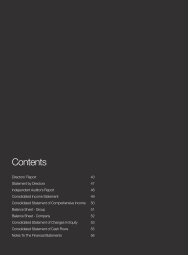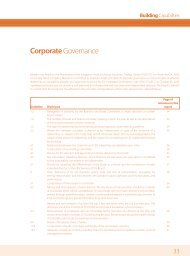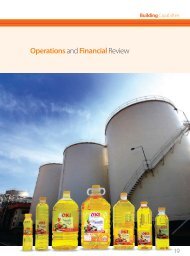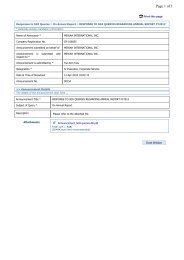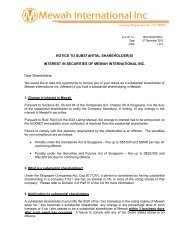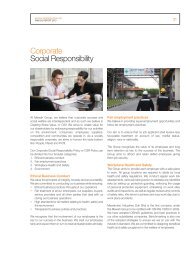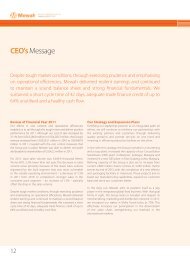Financial Statements - Mewah Group
Financial Statements - Mewah Group
Financial Statements - Mewah Group
You also want an ePaper? Increase the reach of your titles
YUMPU automatically turns print PDFs into web optimized ePapers that Google loves.
Building Capabilities<br />
Notes to the <strong>Financial</strong> <strong>Statements</strong><br />
For the financial year ended 31 December 2011<br />
2. Significant accounting policies (continued)<br />
2.11 Borrowings<br />
Borrowings are presented as current liabilities unless the <strong>Group</strong> has an unconditional right to defer settlement for at least<br />
12 months after the statement of financial position date, in which case they are presented as non-current liabilities.<br />
Borrowings are initially recognised at fair value (net of transaction costs) and subsequently carried at amortised cost. Any<br />
difference between the proceeds (net of transaction costs) and the redemption value is recognised in profit or loss over<br />
the period of the borrowings using the effective interest method.<br />
2.12 Trade and other payables<br />
Trade and other payables represent liabilities for goods and services provided to the group prior to the end of financial<br />
year which are unpaid. They are classified as current liabilities if payment is due within one year or less (or in the normal<br />
operating cycle of the business if longer). If not, they are presented as non-current liabilities.<br />
Trade and other payables are initially recognised at fair value, and subsequently carried at amortised cost using the<br />
effective interest method.<br />
2.13 Derivative financial instruments<br />
Derivative financial instruments comprise mainly of crude palm oil and palm oil products forward contracts, futures<br />
contracts and currency forward contracts.<br />
A derivative financial instrument is initially recognised at its fair value on the date the contract is entered into and is<br />
subsequently carried at its fair value. Fair value changes on derivatives that are not designated or do not qualify for hedge<br />
accounting are recognised in profit or loss within “cost of sales” when the changes arise.<br />
Derivative financial instruments are reported in the financial statements on a net basis where legal right of setoff exists.<br />
Derivative financial instruments are carried as assets when fair value is positive and as liabilities when fair value is negative.<br />
2.14 Fair value estimation of financial assets and liabilities<br />
The fair values of financial instruments traded in active markets (such as exchange-traded and over-the-counter securities<br />
and derivatives) are based on quoted market prices at the statement of financial position date. The quoted market prices<br />
used for financial assets are the current bid prices; the appropriate quoted market prices for financial liabilities are the<br />
current asking prices.<br />
69



